Allergy (Allergies)
- Allergy facts
- Allergy overview
- What is an allergy?
- What is an allergy? (Continued)
- What are common types of allergic conditions, and what are allergy symptoms and signs?
- Allergic rhinitis (hay fever)
- Asthma
- Allergic eyes (conjunctivitis)
- Eczema (atopic dermatitis)
- Hives (urticaria)
- Anaphylaxis
- Where are allergens?
- In the air we breathe
- In what we ingest
- Touching our skin
- Injected into our bodies

Allergy facts
- Allergy involves an exaggerated response of the immune system, often to common substances such as foods, furry animal dander, or pollen.
- The immune system is a complex system that normally defends the body against foreign invaders, such as bacteria and viruses, while also surveying for abnormal changes in an individual's own cells.
- Allergens are substances that are foreign to the body and that cause an allergic reaction.
- IgE is the allergic antibody. The other antibodies, IgG, IgM, and IgA, defend against infection.
- Although many individuals outgrow allergies over time, allergies can also develop at any age, including during adulthood.
- The environment plays a role in the development of allergy, as do genetics. There is a greater risk of developing allergic conditions if a person has a family history of allergy, especially in parents or siblings.
Allergy overview
This is a review regarding how the allergic response of the immune system occurs and why certain people become allergic. The most common allergic diseases are described, including allergic rhinitis (nasal allergies), allergic conjunctivitis (eye allergies), allergic asthma, urticaria (hives), and food allergies.
What is an allergy?
An allergy is an exaggerated reaction by the immune system in response to exposure to certain foreign substances. The response is exaggerated because these foreign substances are normally seen as harmless by the immune system in nonallergic individuals and do not cause a response in them. In allergic individuals, the body recognizes the substance as foreign, and the allergic part of the immune system generates a response.
Allergy-producing substances are called "allergens." Examples of allergens include pollens, dust mites, molds, animal proteins, foods, and medications. When an allergic individual comes in contact with an allergen, the immune system mounts a response through the IgE antibody. People who are prone to allergies are said to be allergic or "atopic."
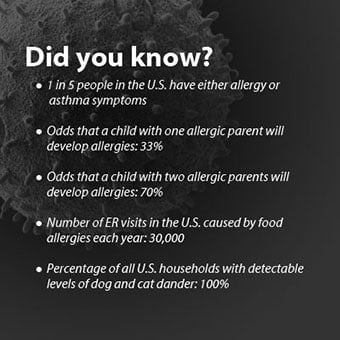
What is an allergy? (Continued)
Allergy prevalence:
- Approximately 10%-30% of individuals in the industrialized world are affected by allergic conditions, and this number is increasing.
- Allergic rhinitis (nasal allergies) affects roughly 20% of Americans. Between prescription costs, physician visits, and missed days of work/school, the economic burden of allergic disease exceeds $3 billion annually.
- Asthma affects roughly 8%-10% of Americans. The estimated health costs for asthma exceed approximately $20 billion annually.
- Food allergies affect roughly 3%-6% of children in the United States, and about 1%-2% of adults in the U.S.
- The prevalence of allergic conditions has increased significantly over the last two decades and continues to rise.

What causes allergies?
A common scenario can help explain how allergies develop. A few months after the new cat arrives in the house, dad begins to have itchy eyes and episodes of sneezing. One of the three children develops coughing and wheezing. The mom and the other two children experience no reaction despite the presence of the cat. How can this occur?
The immune system is the body's organized defense mechanism against foreign invaders, particularly infections. Its job is to recognize and react to these foreign substances, which are called antigens. Antigens often lead to an immune response through the production of antibodies, which are protective proteins that are specifically targeted against particular antigens. These antibodies, or immunoglobulins (IgG, IgM, and IgA), are protective and help destroy a foreign particle by attaching to its surface, thereby making it easier for other immune cells to destroy it. The allergic person, however, develops a specific type of antibody called immunoglobulin E, or IgE, in response to certain normally harmless foreign substances, such as cat dander, pollen, or foods. Other antigens, such as bacteria, do not lead to the production of IgE, and therefore do not cause allergic reactions. Once IgE is formed, it can recognize the antigen and can then trigger an allergic response. IgE was discovered and named in 1967 by Kimishige and Teriko Ishizaka.
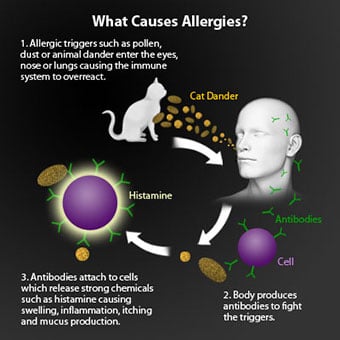
What causes allergies? (Continued)
In the pet cat example, the dad and the youngest daughter developed IgE antibodies in large amounts that were targeted against the cat allergen. The dad and daughter are now sensitized, or prone to develop allergic reactions, on repeated exposures to cat allergen. Typically, there is a period of sensitization ranging from days to years prior to an allergic response. Although it might occasionally appear that an allergic reaction has occurred on the first exposure to the allergen, there needs to be prior exposure in order for the immune system to react. It is important to realize that it is impossible to be allergic to something that an individual has truly never been exposed to before, though the first exposure may be subtle or unknown. The first exposure can even occur in a baby in the womb, through breast milk, or through the skin.
IgE is an antibody that all of us have in small amounts. Allergic individuals, however, generally produce IgE in larger quantities. Historically, this antibody was important in protecting us from parasites. In the example above, during a sensitization period, cat dander IgE is overproduced and coats other cells involved in the allergic response, such as mast cells and basophils, which contain various chemical messengers, such as histamine. These cells produce chemical messengers that cause the symptoms of an allergic reaction on subsequent exposures to the cat allergen. The cat protein is recognized by the IgE, leading to activation of the cells, which leads to the release of the allergic mediators mentioned above. These chemicals cause typical allergic symptoms, such as localized swelling, inflammation, itching, and mucus production. Once primed, or sensitized, the immune system is capable of mounting this exaggerated response with subsequent exposures to the allergen.
On exposure to cat dander, whereas the dad and daughter produce IgE, the mom and the other two children produce other classes of antibodies, which do not cause allergic reactions. In these nonallergic members of the family, the cat protein is eliminated uneventfully by the immune system and the cat has no effect on them.
Another part of the immune system, the T-cell, may be involved in allergic responses in the skin, as occurs from the oils of plants, such as poison ivy, poison oak, poison sumac, reactions to metal, such as nickel, or certain chemicals. The T-cell may recognize a certain allergen in a substance contacting the skin and cause an inflammatory response. This inflammatory response can cause an itchy rash.

Who is at risk for allergies and why?
Allergies can develop at any age, but most food allergies begin at a young age, and many are outgrown. Environmental allergies can develop at any time. The initial exposure or sensitization period may even begin before birth. Individuals can also outgrow allergies over time. It is not fully understood why one person develops allergies and another does not, but there are several risk factors for allergic conditions. Family history, or genetics, plays a large role, with a higher risk for allergies if parents or siblings have allergies. There are numerous other risk factors for developing allergic conditions. Children born via Cesarean section have a higher risk of allergy as compared to children who are delivered vaginally. Exposure to tobacco smoke and air pollution increases the risk of allergy. Boys are more likely to be allergic than girls. Allergies are more common in westernized countries, and less common in those with a farming lifestyle. Timing of exposures to antigens, use of antibiotics, and numerous other factors, some of which are not yet known, also contribute to the development of allergies. This complicated process continues to be an area of medical research.
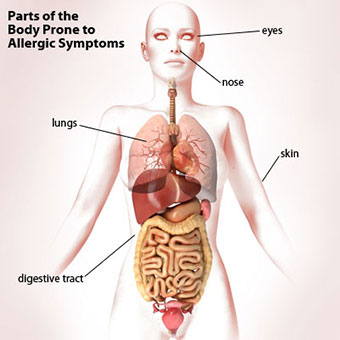
What are common types of allergic conditions, and what are allergy symptoms and signs?
The parts of the body that are prone to allergic symptoms include the eyes, nose, lungs, skin, and gastrointestinal tract. Although the various allergic diseases may appear different, they all result from an exaggerated immune response to foreign substances in sensitive individuals. The following are brief descriptions of common allergic disorders.
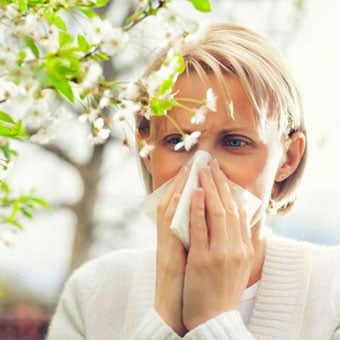
Allergic rhinitis (hay fever)
Allergic rhinitis ("hay fever") is the most common of the allergic diseases and refers to nasal symptoms that are due to aeroallergens. Year-round, or perennial, allergic rhinitis is usually caused by indoor allergens, such as dust mites, animal dander, or molds. Seasonal allergic rhinitis is typically caused by tree, grass, or weed pollens. Many individuals have a combination of both seasonal and perennial allergies. Symptoms result from the inflammation of the tissues that line the inside of the nose after exposure to allergens. The ears, sinuses, and throat can also be involved. The most common symptoms include the following:
- Runny nose
- Stuffy nose
- Sneezing
- Itchy nose, ears, and throat
- Postnasal drip (throat clearing)
In 1819, an English physician, John Bostock, first described hay fever by detailing his own seasonal nasal symptoms, which he called "summer catarrh." The condition was called hay fever because it was thought to be caused by "new hay."

Asthma
Asthma is a respiratory condition that results from inflammation and hyperreactivity of the airways, leading to recurrent, reversible narrowing of the airways. Asthma can often coexist with allergic rhinitis. Other common triggers include respiratory viral infections and exercise. Common symptoms include the following:
- Shortness of breath
- Wheezing
- Coughing
- Chest tightness

Allergic eyes (conjunctivitis)
Allergic eyes (conjunctivitis) are inflammation of the tissue layers (membranes) that cover the surface of the eyeball and the undersurface of the eyelid. The inflammation occurs as a result of an allergic reaction and may produce the following symptoms, which are generally present in both eyes:
- Redness under the lids and of the eye overall
- Watery, itchy eyes
- Swelling of the membranes

Eczema (atopic dermatitis)
Eczema (atopic dermatitis) is a condition commonly found in infants. It tends to occur in individuals at risk for other allergic conditions (asthma and allergic rhinitis) but is not usually caused by direct allergen exposure. The rash results from a complicated inflammatory process. Common features include the following:
- Dry skin associated with significant itching
- Involvement of the face, the front of elbows, and behind knees, though the rash can occur anywhere
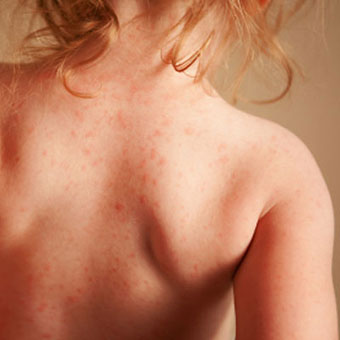
Hives (urticaria)
Hives (urticaria) are skin reactions that appear as red, raised, itchy welts and can occur on any part of the body. Short-lived (acute) hives are often due to an allergic reaction to a food or medication, though they also commonly result from a viral infection in children. They can also result from contact (such as licking) from cats or dogs. Hives that recur over a longer period (chronic hives) are rarely due to an allergic reaction. Hives are characterized by
- raised, red, welts that resolve over hours to a day;
- intense itching (typically not painful);
- no residual marks or bruising upon resolution; and
- swelling (particularly of the lips, face, hands, and feet).
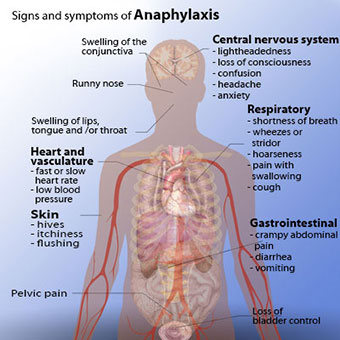
Anaphylaxis
Anaphylactic shock is a potentially life-threatening allergic reaction that can affect a number of organs at the same time. Allergens that typically lead to anaphylaxis are foods, medications, and venom (bee stings). Environmental allergens rarely lead to anaphylaxis, except anaphylaxis can result from allergy shots (subcutaneous immunotherapy). Some or all of the following symptoms may occur:
- Hives itching or flushing present in 80%-90% of cases
- Nasal congestion, runny nose, itchy eyes
- Swelling of the tongue and/or throat
- Abdominal discomfort, nausea, vomiting, diarrhea
- Shortness of breath, wheezing, coughing
- Low blood pressure, leading to lightheadedness, passing out, or shock
Anaphylactic shock is an emergent, life-threatening condition that occurs when blood vessels dilate excessively due to an allergic reaction, which causes a significant drop in blood pressure. This can result in inadequate blood flow to the organs in the body.

Where are allergens?
Allergens may be inhaled, ingested (eaten or swallowed), applied to the skin, or injected into the body either as a medication or inadvertently by an insect sting. The symptoms and conditions that result depend largely on the route of entry and the type of allergen. The chemical structure of allergens affects the route of exposure. Airborne pollens, for example, tend to have little effect on the skin. They are easily inhaled and will thus cause more nasal and respiratory symptoms with limited skin symptoms. When allergens are swallowed or injected, they may travel to other parts of the body and provoke symptoms that are remote from their point of entry. For example, allergens in foods may prompt the release of mediators in the skin and cause hives.
The specific protein structure is what determines the allergen's characteristics. Cat protein, Fel d 1, from the Felis domesticus (the domesticated cat), is the predominant cat allergen. Each allergen has a unique protein structure leading to its allergic characteristics.
In the air we breathe
Aside from oxygen, the air contains a wide variety of particles, including allergens. The usual diseases that result from airborne allergens are hay fever, asthma, and conjunctivitis. The following allergens can trigger allergic reactions when inhaled by sensitized individuals.
- Pollens from trees, grasses, and/or weeds
- Dust mites
- Animal proteins, including dander, skin, and/or urine
- Mold spores
- Insect parts, especially from cockroaches

In what we ingest
Foods and medications can also cause allergic reactions, some of which can be severe. These reactions often start with localized tingling or itching and then may lead to a rash or additional symptoms, such as swelling, nausea, vomiting, diarrhea, or difficulty breathing. Here are the two most common allergens that are ingested:
- Foods: The most common food allergens are cow's milk, eggs, peanuts, tree nuts, wheat, soy, shellfish, finned fish, and sesame. Cow's milk, egg, wheat, and soy allergies are most common in children and are often outgrown over time. The most common allergens in adults are peanut, tree nuts, and shellfish. It should be noted that gluten is not a common food allergy, and true gluten hypersensitivity, or celiac disease, is mediated by another type of antibody (not IgE but IgA) and also leads to different symptoms (including chronic abdominal discomfort, nausea, vomiting, change in stool, and anemia).
- Medications: Although any medication can cause an allergic reaction, common examples include antibiotics and anti-inflammatory agents, such as aspirin and ibuprofen. Notably, many individuals who think they are allergic to medications actually can tolerate the medication without difficulty.
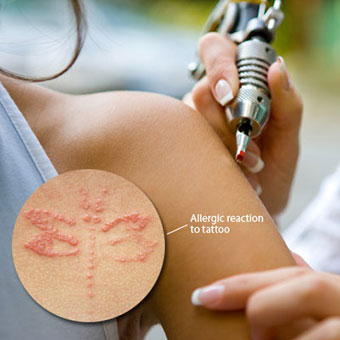
Touching our skin
Contact dermatitis is an inflammation of the skin that is caused by local exposure to a substance. The majority of these localized skin reactions do not involve IgE but are caused by other inflammatory cells. A good example is poison ivy. Examples of substances that commonly cause contact dermatitis include the following:
- Plants (poison ivy, poison sumac, and poison oak)
- Latex
- Personal care product ingredients
- Nickel and other metals
- Cosmetics

Injected into our bodies
The most severe reactions often occur when allergens are injected into the body and gain direct access to the bloodstream. This intravenous access carries the increased risk of a systemic reaction, such as anaphylaxis. The following are commonly injected allergens that can cause severe allergic reactions:
- Insect venom
- Medications
- Allergy shots
What specialists treat people with allergies?
Although primary care physicians are able to treat mild allergic symptoms, allergy/immunology physicians (allergists) treat individuals with more significant allergies. Many allergists treat both children and adults, but some are specialized to either patient group alone.
How do health care professionals diagnose allergies? What are the types of allergy testing?
The diagnosis of allergies begins with a detailed history and physical examination. Many people with allergies have other family members with allergic conditions. In addition to the history and exam, skin testing and sometimes blood work (specific IgE levels) can help with the diagnosis of allergies. There are several important considerations when interpreting the results of this testing:
- For environmental allergies such as pets, dust mites, pollen, and molds, skin prick testing is the best test to help with diagnosis of allergy. Blood work looking for the allergic antibody (IgE) is less sensitive and may miss some allergies.
- For food allergy testing, the most important part of the diagnosis is the health history. Skin testing or blood work (specific IgE testing) should only be ordered if the history is suggestive of food allergy. Without a suggestive history, food allergy skin testing and blood work is not very specific and has a high rate of false positive results.
- For food allergy testing, ordering skin testing or blood work (specific IgE testing) for broad panels of foods is discouraged, given the high rate of false positive results.
- For drug allergy, the history is the most important element in diagnosis. The only antibiotic with validated skin testing is penicillin. Penicillin skin testing can be very helpful in determining if an individual is truly allergic to penicillin and related antibiotics. Blood work (specific IgE testing) is not particularly helpful for the diagnosis of drug allergies.
- Sometimes, such as with food allergy and drug allergy, despite a detailed history and appropriate testing, the diagnosis of allergy remains unclear. In these situations, it is appropriate to consider a “graded challenge,” which is the “gold standard,” or the best test, for the diagnosis of allergies. A graded challenge should always be performed with an allergist in a setting equipped to manage a severe allergic reaction, such as anaphylaxis.

What are treatment options and medicines for allergies?
The treatment for allergies depends on the particular condition. Some general guidelines are as follows:
Allergic rhinitis and conjunctivitis
- Environmental control measures: These have limited efficacy.
- For dust mites, it helps to decrease humidity in the home and wash bedding in hot water once weekly.
- For pets, avoidance is most effective. Cat allergen is airborne, so having a cat in the home will cause allergic symptoms. Keeping dogs out of the bedroom may help reduce symptoms. Bathing both cats and dogs may decrease the allergen burden somewhat. There is no such thing as a hypoallergenic dog, but hypoallergenic cats have been bred. For pollen, keeping windows closed and staying indoors on high pollen days may be helpful.
- Oral antihistamines
- Nasal antihistamines
- Antihistamine eyedrops
- Nasal corticosteroids
- Allergen immunotherapy (see below)
Asthma
- Rescue inhalers
- Inhaled corticosteroids, inhaled corticosteroids/long-acting bronchodilator combinations, long-acting anti-muscarinic medications
- Oral maintenance medications (anti-leukotriene medications, theophylline)
- Injectable medications, called "biologics" that must be administered at a medical facility or sometimes at home
- Allergen immunotherapy (see below)
- Oral steroids
- Routine moisturization
- Topical corticosteroids
- Oral antihistamines to help control itching
- Immunosuppressive medications in severe cases
- An injectable biologic medication, dupilumab (Dupixent)
Hives (urticaria)
- Oral antihistamines
- Oral steroids
- Injectable medications (biologic) administered in a medical facility
- Immunosupressive medications in severe cases
Anaphylaxis
- Epinephrine is the one and only treatment for anaphylaxis, which is a severe allergic reaction that can involve multiple body systems and is life threatening. Epinephrine is administered in a medical facility or outside of a medical facility with an auto-injector into the muscle in the lateral thigh. Up to 20%-30% of severe allergic reactions may require treatment with more than one dose of epinephrine, so individuals who carry epinephrine should ideally carry two auto-injectors. If an individual experiences anaphylaxis and uses epinephrine, they should call 911 to be appropriately monitored. Antihistamines such as diphenhydramine (Benadryl) are not appropriate treatments of anaphylaxis.
Allergen immunotherapy (allergy shots)
- Allergy shots have been shown to decrease symptoms of environmental allergies and asthma and may also be beneficial in eczema. Allergy shots should be prescribed by an allergist and should always be administered in a health care facility equipped to manage a serious allergic reaction (anaphylaxis). Allergy shots help make the body less sensitive to the culprit allergen, such as pets, dust mites, pollens, and molds.
- Recently, the FDA has also approved immunotherapy that can be administered with a tablet under the tongue (sublingual immunotherapy). To date, this is only available for grass, ragweed, and dust mite. Unlike allergy shots, sublingual immunotherapy can be administered at home because the risk of a severe allergic reaction is lower with sublingual therapy.
- Of note, although there is significant research being done in the area, immunotherapy not FDA-approved to treat food allergies. The treatment of food allergy remains avoidance of the culprit food and management of accidental exposures with the appropriate medications.

Are there home remedies for allergies?
Although there is significant research examining the role of vitamins, herbal medications, and other therapies on the treatment of allergies, there are currently no proven home remedies that successfully treat allergies.
What is the prognosis of allergies?
People with allergies have an excellent prognosis. Many children outgrow allergies over time, particularly food and medication allergies, such as penicillin. On the other hand, allergies can develop at any age. Allergies should not affect life expectancy, and with proper management, the majority of individuals with allergies should maintain an acceptable quality of life.
Is it possible to prevent allergies?
With the increasing prevalence of allergic conditions, many studies have examined risk factors for allergies and how to modify these to potentially prevent allergies. The development of allergies results from a complex interplay between a person’s genetic make-up (genotype) and its interaction with the environment (phenotype). Having family members with allergic conditions increases the risk of allergy. Numerous environmental influences may also affect the development of allergy, such as breastfeeding, cesarean sections, diet during pregnancy, vitamin D levels, use of antibiotics, use of probiotics, animal exposures, bacterial exposures, pollutant exposure, and diet during infancy. Of all the factors studied to date, it appears that introducing highly allergic foods into the child’s diet before one year of age may decrease the risk of food allergy, particularly peanut allergy. Allergen immunotherapy (allergy shots) have also been shown to decrease the risk of developing future environmental allergies and asthma. Finding additional ways to prevent allergic conditions remains an active area of research.

